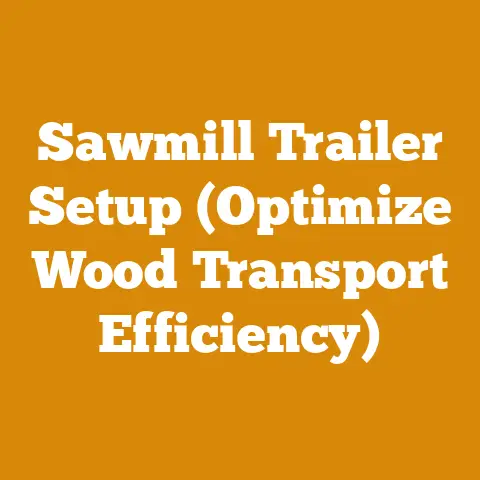Dump Trailer Side Extensions for Wood Hauling (5 Pro Tips)
Dump Trailer Side Extensions for Wood Hauling: 5 Pro Tips
First impressions matter, right? When I first started hauling wood, my little dump trailer felt like a toy. I was making so many trips, burning through gas, and wasting precious daylight. That’s when I started looking at side extensions. They seemed like a simple solution, but as I quickly learned, there’s a lot more to it than just slapping some wood onto the sides. This guide is born out of my early struggles and subsequent successes, designed to help you avoid common pitfalls and maximize your wood-hauling efficiency safely and effectively.
1. Understanding Your Needs and Trailer Capacity
Before you even think about building those extensions, you need to understand why you’re doing it and what your trailer can handle.
- Why Extensions?: Are you looking to haul more volume of lighter wood (like seasoned firewood) or are you trying to get larger, heavier logs from point A to point B? This will dictate the materials and construction methods you use.
-
Trailer Capacity: This is critical. Overloading your trailer can damage the axles, suspension, and even the frame. Check your trailer’s GVWR (Gross Vehicle Weight Rating) and GAWR (Gross Axle Weight Rating). This information is usually found on a sticker or plate on the trailer frame. Don’t exceed these limits!
- GVWR: The maximum permissible weight of the trailer and its load.
- GAWR: The maximum weight each axle can handle.
Example: Let’s say your trailer has a GVWR of 7,000 lbs and an empty weight of 2,000 lbs. That means you can legally haul 5,000 lbs of wood.
-
State and Local Regulations: Check your local laws regarding trailer dimensions and load securement. Many states have restrictions on the maximum width and height of loads. Ignorance is no excuse, and fines can be hefty.
Personal Story: I once saw a guy with a trailer that looked like it was about to tip over. He’d built these massive extensions but hadn’t considered the weight. The axles were visibly straining, and he was weaving all over the road. It was a disaster waiting to happen. Don’t be that guy.
Data Point: According to the National Association of Trailer Manufacturers (NATM), approximately 80% of trailer failures are due to overloading or improper maintenance.
2. Choosing the Right Materials
The materials you use for your side extensions will significantly impact their strength, durability, and weight. Here’s a breakdown of common options:
-
Wood:
- Pros: Relatively inexpensive, easy to work with, readily available.
- Cons: Susceptible to rot, insects, and weather damage. Requires regular maintenance.
- Recommended Types: Pressure-treated lumber (for longevity), oak or ash (for strength), plywood (for lightweight applications).
- Technical Specs:
- Pressure-Treated Lumber: Look for lumber treated to a UC4A rating for ground contact. This means it’s suitable for direct burial and will resist rot and insect damage for many years.
- Oak/Ash: These hardwoods have a bending strength of around 10,000-15,000 psi (pounds per square inch). This is crucial for resisting the outward pressure from the wood load.
- Plywood: Use exterior-grade plywood (CDX or better) for water resistance. Minimum thickness of ¾ inch is recommended for most applications.
- My Experience: I initially used untreated pine for my extensions. Big mistake! They rotted within a year. The extra cost of pressure-treated lumber is well worth it in the long run.
-
Metal:
-
Pros: Extremely strong and durable, weather-resistant.
- Cons: More expensive than wood, requires welding skills or professional fabrication. Can add significant weight to the trailer.
- Recommended Types: Steel (for strength), aluminum (for lightweight applications).
- Technical Specs:
- Steel: Use at least 14-gauge steel (0.0747 inches thick) for the frame and 16-gauge steel (0.0598 inches thick) for the sides. Mild steel (A36) is a good balance of strength and cost.
- Aluminum: 6061-T6 aluminum is a common choice for its strength-to-weight ratio. Use at least 1/8 inch (0.125 inches) thickness for the frame and sides.
- Case Study: A local logging company switched from wood to steel extensions on their fleet of dump trailers. They reported a 50% reduction in maintenance costs and a significant increase in the lifespan of the extensions.
-
Composite Materials:
-
Pros: Lightweight, durable, weather-resistant.
- Cons: Most expensive option, may require specialized tools for cutting and fastening.
- Recommended Types: Plastic lumber, fiberglass reinforced plastic (FRP).
- Technical Specs:
- Plastic Lumber: Look for products made from recycled polyethylene (HDPE) or polypropylene (PP). These materials are resistant to rot, insects, and UV damage.
- FRP: FRP panels offer excellent strength and stiffness. Choose a thickness appropriate for the load you’ll be carrying.
- Insight: Composite materials are becoming increasingly popular for their low maintenance and long lifespan. While the initial cost is higher, the long-term savings can be significant.
Key Consideration: Regardless of the material you choose, ensure it is compatible with the trailer’s existing structure. Galvanic corrosion can occur when dissimilar metals are in contact, leading to premature failure. Use appropriate fasteners and isolation techniques to prevent this.
3. Designing and Building Your Extensions
Now for the fun part! Here’s a step-by-step guide to designing and building your dump trailer side extensions.
- Step 1: Measure Your Trailer: Accurately measure the inside dimensions of your trailer bed. This will determine the size of your extensions. Pay close attention to the location of stake pockets or other mounting points.
- Step 2: Determine the Height of Your Extensions: Consider the type of wood you’ll be hauling and the desired volume increase. A common height is 12-24 inches, but this will vary depending on your needs.
-
Step 3: Design Your Extensions: Sketch out your design, including the dimensions of each piece of material. Consider using a CAD program for a more precise design.
- Frame Construction: The frame is the backbone of your extensions. Use a strong and rigid material, such as steel or pressure-treated lumber.
- Side Panels: The side panels can be made from wood, metal, or composite materials. Ensure they are securely attached to the frame.
- Fastening Methods: Choose appropriate fasteners for the materials you are using. Bolts and screws are generally stronger than nails. Welding is the preferred method for metal construction.
- Hinged or Removable Extensions: Consider making your extensions hinged or removable for added versatility. This allows you to easily switch between hauling wood and other materials.
-
Step 4: Gather Your Materials and Tools: Make a list of all the materials and tools you’ll need. This will save you time and frustration later.
- Materials: Lumber, steel, composite panels, fasteners, paint or sealant.
- Tools: Saw, drill, measuring tape, square, level, welding equipment (if using metal), safety glasses, gloves.
- Step 5: Build Your Extensions: Follow your design and carefully assemble the extensions. Pay attention to detail and ensure all connections are strong and secure.
- Cutting: Cut all materials to the correct dimensions. Use a sharp saw for clean and accurate cuts.
- Assembly: Assemble the frame and side panels. Use appropriate fasteners or welding techniques to join the pieces together.
- Finishing: Apply paint or sealant to protect the extensions from the elements. This will extend their lifespan.
- Step 6: Attach the Extensions to Your Trailer: Securely attach the extensions to your trailer using stake pockets, bolts, or other mounting methods. Ensure the extensions are properly aligned and do not interfere with the trailer’s operation.
- Stake Pockets: Stake pockets are a common and convenient way to attach extensions. Simply slide the frame of the extension into the stake pockets and secure it with bolts or pins.
- Bolts: Drill holes through the trailer frame and the extension frame and secure them with bolts. Use lock washers to prevent the bolts from loosening over time.
- Welding: If using metal extensions, you can weld them directly to the trailer frame. This is the strongest and most secure method of attachment.
Technical Tip: When attaching the extensions, use a torque wrench to ensure the fasteners are tightened to the correct specification. Overtightening can damage the fasteners or the trailer frame.
Diagram Example: (Imagine a simple CAD drawing here showing a dump trailer with side extensions. The diagram should label key components like the frame, side panels, stake pockets, and fasteners. Include dimensions for a typical extension height and width.)
Personal Experience: My first set of extensions were wobbly and unstable. I quickly realized I had skimped on the frame. Reinforcing the frame with additional supports made a huge difference. Don’t cut corners on the structural integrity of your extensions.
4. Load Securement and Safety
Hauling wood safely is paramount. Here’s what you need to know about load securement and safety.
- Load Securement: Properly securing your load is essential to prevent accidents and fines.
- Straps: Use heavy-duty ratchet straps to secure the wood to the trailer. Ensure the straps are rated for the weight of the load.
- Strap Rating: Look for straps with a working load limit (WLL) that is greater than the weight of your load.
- Strap Placement: Place straps over the top of the load and around the sides of the trailer. Tighten the straps securely.
- Chains: Chains are a stronger option for securing heavy logs. Use chains with a working load limit that is greater than the weight of the load.
- Chain Grade: Use Grade 70 transport chain or higher for hauling wood.
- Chain Placement: Place chains over the top of the load and around the sides of the trailer. Use chain binders to tighten the chains securely.
- Nets: Cargo nets can be used to secure loose firewood. Ensure the net is rated for the weight of the load.
- Net Material: Use a heavy-duty cargo net made from nylon or polyester.
- Net Attachment: Attach the net to the trailer using hooks or straps.
- Load Distribution: Distribute the load evenly across the trailer bed. This will prevent the trailer from becoming unbalanced.
- Weight Distribution: Place heavier logs at the bottom of the load and lighter wood on top.
- Center of Gravity: Keep the center of gravity as low as possible to improve stability.
- Straps: Use heavy-duty ratchet straps to secure the wood to the trailer. Ensure the straps are rated for the weight of the load.
- Safety Equipment: Always wear appropriate safety equipment when hauling wood.
- Gloves: Wear heavy-duty gloves to protect your hands from splinters and cuts.
- Safety Glasses: Wear safety glasses to protect your eyes from flying debris.
- Steel-Toed Boots: Wear steel-toed boots to protect your feet from falling logs.
- High-Visibility Clothing: Wear high-visibility clothing to make yourself more visible to other drivers.
- Driving Safety: Drive carefully and defensively when hauling wood.
- Speed: Reduce your speed, especially on curves and hills.
- Braking: Allow extra distance for braking.
- Turning: Make wide turns to avoid tipping the trailer.
- Road Conditions: Be aware of road conditions and adjust your driving accordingly.
Data Point: According to the Federal Motor Carrier Safety Administration (FMCSA), improper load securement is a leading cause of accidents involving commercial vehicles.
Legal Requirement: Many states require loads to be covered with a tarp to prevent debris from falling onto the road. Check your local laws for specific requirements.
My Mistake: I once forgot to secure a load of firewood properly. A few pieces fell off the trailer while I was driving. Fortunately, no one was hurt, but it was a close call. I learned my lesson and now I always double-check my load securement.
5. Maintenance and Longevity
Proper maintenance is key to extending the life of your dump trailer side extensions.
- Regular Inspections: Inspect your extensions regularly for signs of damage or wear.
- Wood: Check for rot, cracks, and insect damage.
- Metal: Check for rust, corrosion, and cracks.
- Composite: Check for cracks, delamination, and UV damage.
- Fasteners: Check for loose or corroded fasteners.
- Repairs: Repair any damage immediately to prevent it from worsening.
- Wood: Replace rotted or damaged wood.
- Metal: Weld cracks or replace corroded sections.
- Composite: Repair cracks with epoxy or replace damaged panels.
- Fasteners: Tighten or replace loose or corroded fasteners.
- Cleaning: Clean your extensions regularly to remove dirt, debris, and salt.
- Wood: Use a mild detergent and water to clean wood extensions.
- Metal: Use a pressure washer to clean metal extensions.
- Composite: Use a mild detergent and water to clean composite extensions.
- Protection: Protect your extensions from the elements to extend their lifespan.
- Wood: Apply a sealant or paint to protect wood extensions from moisture and UV damage.
- Metal: Apply a rust-inhibiting primer and paint to protect metal extensions from corrosion.
- Composite: Apply a UV protectant to protect composite extensions from UV damage.
- Storage: Store your extensions in a dry place when not in use. This will prevent them from rotting or corroding.
Technical Specification: Wood sealants should have a minimum solids content of 30% and a UV resistance rating of at least 3 years.
Best Practice: Apply a coat of marine-grade varnish to wood extensions every year to provide maximum protection against the elements.
My Tip: I keep a small toolbox in my truck with essential repair tools, such as a wrench, screwdriver, and some extra fasteners. This allows me to make minor repairs on the spot.
Final Thoughts: Building and using dump trailer side extensions for wood hauling can significantly increase your efficiency and reduce the number of trips you need to make. However, it’s important to prioritize safety and follow best practices to avoid accidents and damage to your equipment. By understanding your needs, choosing the right materials, designing and building your extensions carefully, securing your load properly, and maintaining your extensions regularly, you can enjoy years of reliable service. Happy hauling!






